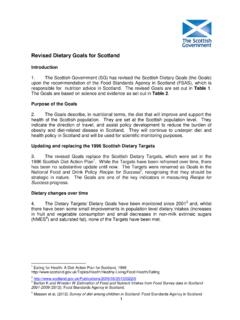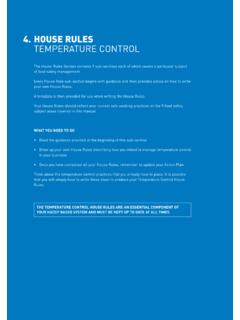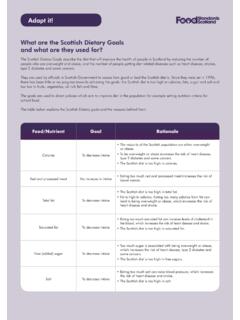Transcription of Guidance on Temperature Control - Food Standards Scotland
1 Guidance on Temperature Control Legislation in the United Kingdom Regulation (EC) 852/2004. The Food Safety and Hygiene (England) Regulations 2013. The Food Hygiene ( Scotland ) Regulations 2006. The Food Hygiene (Wales) Regulations 2006. The Food Hygiene Regulations (Northern Ireland) 2006. Food Standards Agency May 2016. 1. If you require this information in an alternative format such as audio, large print or Braille please contact us: TELEPHONE: 020 7276 8940. EMAIL: Summary Intended audience - Catering and retailing food businesses - Food businesses that are not approved - Local authority officers. Regional coverage UK. Purpose To provide an explanation of the Temperature Control requirements for food, how they apply and the foodstuffs concerned. Legal status This Guidance accompanies the regulations. Key words - Food hygiene - Food Temperature controls Review date June 2018.
2 Revision history Revision date Purpose of revision Revised by 1 July 2006 Pre consultation Simon Petty September 2 Post consultation Simon Petty 2007. Routine updates and corrections reflecting: - changes to national legislation in England in 2013;. David Gray and - the establishment of Food 3 May 2016 Solomon Standards Scotland ;. Okoruwa - changes to the EU labelling regulations and - changes to other relevant public bodies. 2. Contents Section Paragraphs Introduction 1-8. Foods Subject to Temperature Control 9. The General Requirement 10-16. Cooling of Food 17-18. HACCP 19-22. Product Specific Food Hygiene Regulations 23. National Requirements 24-26. Chill Holding England, Wales & Northern Ireland Chill Holding Requirements 27-31. Exemptions from Chill Holding Requirements 32-34. Upward Variation from the 8 C Maximum Chill Temperature 35-41. Chill Holding Tolerance Period 42-49.
3 Scotland Chill Holding Requirements 50-52. Exemptions from Chill Holding Requirements 53. Hot Holding England, Wales & Northern Ireland Hot Holding Requirements 54-55. Downward Variation from the 63 C Minimum Hot Holding Temperature 56. Hot Holding Tolerance Period 57-59. Scotland Hot Holding Requirements 60. Exemptions from Hot Holding Requirements 61. Reheating of Foods 62-66. Scientific Assessment Supporting a Recommended Temperature Variation 67-80. Further Information 81. 3. Introduction 1. This document gives Guidance on the Temperature Control requirements found in the following hygiene legislation: Regulation (EC) 852/2004 1. The Food Safety and Hygiene (England) Regulations 2013. The Food Hygiene Regulations 2006 in Scotland , Wales and Northern Ireland2. 2. This Guidance does not cover the specific Temperature Control requirements contained within Regulation (EC) 853/2004 3 , Regulation (EC) 2073/2005 4 and any further product-specific requirements, such as poultrymeat marketing Standards regulations.
4 Further information can be found at paragraph 23 or on the Foods Standards Agency's (FSA) web site at 3. It is intended that this Guidance will help to explain, both for food business operators and enforcement authorities, the food Temperature Control requirements of the above legislation in the UK. This Guidance contains advice on the types of foods that are required to be held under Temperature Control . It also gives Guidance on the permitted flexibility within the Temperature Control requirements. 4. While it is intended to be helpful, this Guidance does not provide an authoritative interpretation of the law and is no substitute for an understanding of the legal requirements. Any examples given are illustrative and not comprehensive. 5. This Guidance is intended to complement best practices in the food industry, which might involve, for example, keeping foods at chill temperatures below the legal maximum and thereby providing additional assurances of food safety.
5 Best practice will vary according to the product concerned. 6. The Temperature Control requirements should be understood in the general context of the food safety management procedures based on the principles of Hazard Analysis and Critical Control Points (HACCP) requirement contained in Article 5 of Regulation (EC) 852/2004. 7. Advice on the approach to enforcement of the Temperature Control requirements of food hygiene legislation is to be found in the Food Law Codes of Practice and 1. Regulation (EC) No 852/2004 on the hygiene of foodstuffs 2. Separate legislation applies across the four countries of the UK: The Food Safety and Hygiene (England) Regulations 2013; The Food Hygiene ( Scotland ) Regulations 2006 (SSI 2006/3); The Food Hygiene (Wales) Regulations 2006 (SI 2006/31 ( )); and; The Food Hygiene Regulations (Northern Ireland) 2006 (SR 2006 No 3).
6 3. Regulation (EC) No 853/2004 laying down specific hygiene rules for food of animal origin 4. Regulation (EC) No 2073/2005 on microbiological criteria for foodstuffs 4. accompanying Practice Guidance issued to enforcement authorities by the FSA. 8. Further Guidance on compliance with Temperature Control legislation, as well as good practice can be found in recognised National Guides to Good Practice for Hygiene and for the Application of HACCP Principles as well as European Community Guide equivalents. These Guides are recognised by the FSA and the European Commission respectively and have a special status under EU law5. whereby enforcers are required to consider them when assessing compliance with hygiene legislation. 5. Article 10(2)(d) of Regulation (EC) No 882/2004 on official controls performed to ensure the verification of compliance with feed and food law, animal health and animal welfare rules 5.
7 Foods Subject to Temperature Control 9. This paragraph gives some examples of various food types that under normal conditions of storage and use and in the absence of adequate preserving factors should be kept under Temperature Control (both chill and hot holding) so as not to result in a risk to health. These examples are for general Guidance only. There are certain exemptions from the national Temperature Control regulations, see paragraphs 32-34 for those that apply in England, Wales and Northern Ireland and paragraph 53 for those in Scotland . a. Dairy products i. Soft or semi-hard cheeses ripened by moulds and/or bacteria. The important safety factors for cheese relate primarily to its acidity and water activity. Temperature controls do not apply during the ripening process. However, it is important that once cheese has ripened it is placed under chill holding.
8 During the ripening process, acidity declines until a point is reached where growth of pathogens will no longer be inhibited. ii. Dairy-based desserts (including milk substitutes), including fromage frais, mousses, cr me caramel and products containing whipped cream. Where the pH of these products ( yoghurt with a pH below ) would prevent the growth of pathogenic micro-organisms or the formation of toxins, or other effective preservative mechanisms ( pasteurisation) are present, the food would not need to be subject to Temperature Control . b. Cooked products There will be a need for Temperature Control of foods comprising or containing cooked products such as meat, fish, eggs (or substitutes for meat, fish, or eggs), milk, soft cheese, cereals (including rice), pulses and vegetables (whether or not they are intended to be eaten without further re- heating).
9 The requirement will include ready-to-eat products such as sandwiches containing fillings, toppings, etc. prepared with these foods. c. Smoked or cured fish which is not ambient shelf-stable Whilst curing and smoking will inhibit the growth of organisms, the process in itself will not make the fish ambient stable. There is therefore a need for Temperature Control whether the fish is whole or sliced, in the absence of other preservative factors such as canning. In the case of untreated fish, which is not kept frozen or refrigerated, spoilage organisms (which are obviously detectable through appearance or smell) would likely render the 6. product unfit for consumption before it became unsafe so Temperature Control would not always be required for safety reasons. d. Smoked or cured ready-to-eat meat which is not ambient shelf-stable Examples may include sliced cured cooked meats such as hams, some salamis and other fermented sausages, depending on the method of curing.
10 The method of curing, especially if it does not achieve a low water activity, may mean that foods could not be safely kept at ambient temperatures under defined conditions and within their shelf life. e. Prepared ready-to-eat foods Including prepared vegetables, or salads containing other products (such as coleslaw), vegetable salads containing fruit and prepared products such as mayonnaise once opened. f. Uncooked or partly cooked pastry and dough products Examples include products such as pizzas, sausage rolls, or fresh pasta. These products often contain pre-cooked meat, fish or vegetables (or substitutes for meat or fish) mixed or prepared with raw materials. The subsequent cooking process may be insufficient in some cases to ensure food safety, so Temperature Control will be necessary. Fresh pasta should normally be Temperature controlled, whether or not it contains meat, fish or vegetables.









